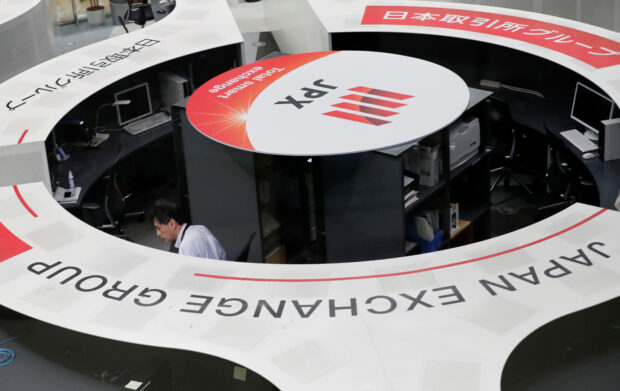
A man works at the Tokyo Stock Exchange after market opens in Tokyo, Japan Oct 2, 2020. REUTERS/Kim Kyung-Hoon/File Photo
SYDNEY – Asia’s stock indexes were mostly higher Tuesday after a tech-led surge on Wall Street as investors await the next set of U.S inflation numbers due this week, which could hint at when the Federal Reserve might start cutting interest rates.
MSCI’s broadest index of Asia-Pacific shares outside Japan was up 0.5 percent, after U.S. stocks ended the previous session with gains.
Australian shares were up 1.17 percent, while Japan’s Nikkei stock index was trading 1.6 percent higher.
In Australia, the S&P/ASX200 bounced higher after November retail sales grew by 2 month on month following a 0.2-percent contraction in October. The result was higher than the 1.2 percent forecast in a Reuters poll.
READ: Wall Street rallies near record heights as Big Tech stocks recover
Hong Kong’s Hang Seng Index was up 0.26 percent while China’s bluechip CSI300 Index fell 0.21 percent.
The dollar dropped 0.21 percent against the yen to 143.9 . It is still some distance from its high this year of 145.98 on Jan 5.
The yen was little changed after Tokyo core inflation data slowed for the second month in December, new data showed on Tuesday.
The result is expected to take some pressure that might encourage the Bank of Japan to quickly exit ultra-loose monetary policy.
The European single currency was up 0.1 percent at $1.0957, having lost 0.72 percent in a month, while the dollar index, which tracks the greenback against a basket of currencies of other major trading partners, was down at 102.19.
The Dow Jones Industrial Average rose 0.58 percent on Monday, the S&P500 gained 1.41 percent, and the Nasdaq climbed 2.2 percent following a strong surge in U.S tech stocks.
In early trade Tuesday, the yield on benchmark 10-year Treasury notes rose to 4.0267 percent compared with its U.S. close of 4.002 percent on Monday.
The two-year yield, which rises with traders’ expectations of higher Fed fund rates, touched 4.3746 percent, compared with a U.S. close of 4.345 percent.
Interest rate cuts
Atlanta Federal Reserve President Raphael Bostic said on Monday that with inflation still above the central bank’s 2 percent target, his bias was towards keeping monetary policy tight.
However, he reiterated his earlier view that he does anticipate rate reductions this year, with two quarter percentage point cuts likely needed by the end of 2024.
READ: With rate hikes likely done, Fed turns to timing of cuts
December’s U.S Consumer Price Index (CPI) reading will be published on Thursday and is expected to show headline inflation rose 0.2 percent in the month and by 3.2 percent on an annual basis.,
“We expect the Fed’s current restrictive settings will continue to slow demand and help the economy return to greater equilibrium,” ANZ economists wrote on Tuesday.
“Expectations for an early rate cut … are high with the market putting a 50-percent chance on a March rate cut. We are less optimistic and believe the Fed will be patient, wanting greater certainty before starting a cutting cycle.”
U.S. crude ticked up 0.16 percent to $70.88 a barrel. Brent crude fell to $76.27 per barrel.
Gold was slightly lower. Spot gold was traded at $2027.7766 per ounce.